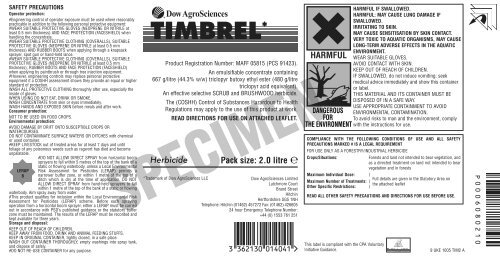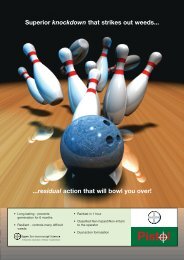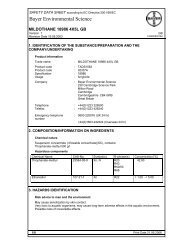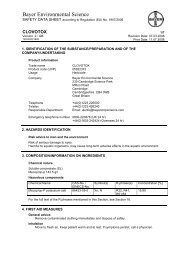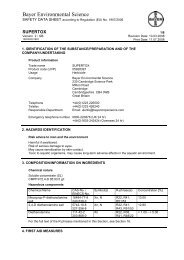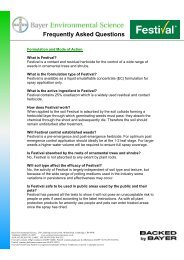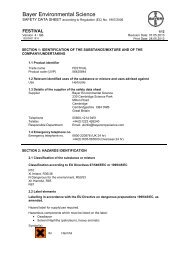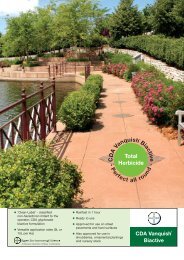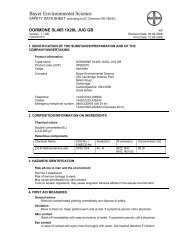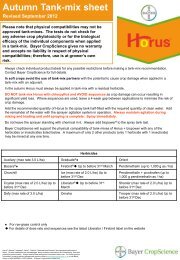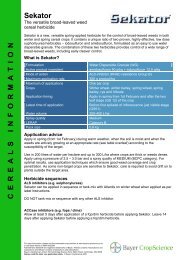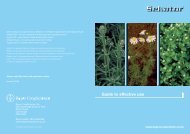TIMBREL* - Bayer Environmental Science Turf & Amenity
TIMBREL* - Bayer Environmental Science Turf & Amenity
TIMBREL* - Bayer Environmental Science Turf & Amenity
You also want an ePaper? Increase the reach of your titles
YUMPU automatically turns print PDFs into web optimized ePapers that Google loves.
SAFETY PRECAUTIONSOperator protection:#Engineering control of operator exposure must be used where reasonablypracticable in addition to the following personal protective equipment:#WEAR SUITABLE PROTECTIVE GLOVES (NEOPRENE OR NITRILE atleast 0.5 mm thickness) AND FACE PROTECTION (FACESHIELD) whenhandling the concentrate.#WEAR SUITABLE PROTECTIVE CLOTHING (COVERALLS), SUITABLEPROTECTIVE GLOVES (NEOPRENE OR NITRILE at least 0.5 mmthickness) AND RUBBER BOOTS when applying through a knapsacksprayer, spot gun or hand-held lance.#WEAR SUITABLE PROTECTIVE CLOTHING (COVERALLS), SUITABLEPROTECTIVE GLOVES (NEOPRENE OR NITRILE at least 0.5 mmthickness), RUBBER BOOTS AND FACE PROTECTION (FACESHIELD)when applying by paintbrush or through tree injection equipment.#However, engineering controls may replace personal protectiveequipment if a COSHH assessment shows they provide an equal or higherstandard of protection.WASH ALL PROTECTIVE CLOTHING thoroughly after use, especially theinside of gloves.WHEN USING DO NOT EAT, DRINK OR SMOKE.WASH CONCENTRATE from skin or eyes immediately.WASH HANDS AND EXPOSED SKIN before meals and after work.Consumer protection:NOT TO BE USED ON FOOD CROPS.<strong>Environmental</strong> protection:AVOID DAMAGE BY DRIFT ONTO SUSCEPTIBLE CROPS ORWATERCOURSES.DO NOT CONTAMINATE SURFACE WATERS OR DITCHES with chemicalor used container.#KEEP LIVESTOCK out of treated areas for at least 7 days and untilfoliage of any poisonous weeds such as ragwort has died and becomeunpalatable.#DO NOT ALLOW DIRECT SPRAY from horizontal boomsprayers to fall within 5 metres of the top of the bank of aLERAPBstatic or flowing waterbody, unless a Local <strong>Environmental</strong>Risk Assessment for Pesticides (LERAP) permits anarrower buffer zone, or within 1 metre of the top of aditch which is dry at the time of application. DO NOTALLOW DIRECT SPRAY from hand-held sprayers to fallwithin 1 metre of the top of the bank of a static or flowingwaterbody. Aim spray away from water.#This product qualifies for inclusion within the Local <strong>Environmental</strong> RiskAssessment for Pesticides (LERAP) scheme. Before each sprayingoperation from a horizontal boom sprayer, either a LERAP must be carriedout in accordance with PSD’s published guidance or the statutory bufferzone must be maintained. The results of the LERAP must be recorded andkept available for three years.Storage and disposal:KEEP OUT OF REACH OF CHILDREN.KEEP AWAY FROM FOOD, DRINK AND ANIMAL FEEDING STUFFS.KEEP IN ORIGINAL CONTAINER, tightly closed, in a safe place.WASH OUT CONTAINER THOROUGHLY, empty washings into spray tank,and dispose of safely.#DO NOT RE-USE CONTAINER for any purpose. DowAgro<strong>Science</strong>sTIMBREL *Product Registration Number: MAFF 05815 (PCS 91423).An emulsifiable concentrate containing667 g/litre (44.3% w/w) triclopyr butoxy ethyl ester (480 g/litretriclopyr acid equivalent).An effective selective SCRUB and BRUSHWOOD herbicide.The (COSHH) Control of Substances Hazardous to HealthRegulations may apply to the use of this product at work.READ DIRECTIONS FOR USE ON ATTACHED LEAFLET.HerbicidePack size: 2.0 litre*Trademark of Dow Agro<strong>Science</strong>s LLCDow Agro<strong>Science</strong>s LimitedLatchmore CourtBrand StreetHitchinHertfordshire SG5 1NHTelephone: Hitchin (01462) 457272 Fax: (01462) 42660524 hour Emergency Telephone Number:+44 (0) 1553 761 2513 362130 014041HARMFULDANGEROUSFORTHE ENVIRONMENTCOMPLIANCE WITH THE FOLLOWING CONDITIONS OF USE AND ALL SAFETYPRECAUTIONS MARKED # IS A LEGAL REQUIREMENTFOR USE ONLY AS A FORESTRY/INDUSTRIAL HERBICIDECrops/Situations:Forests and land not intended to bear vegetation, andas a directed treatment on land not intended to bearvegetation and in forestsMaximum Individual Dose: }Full details are given in the Statutory Area onMaximum Number of Treatments: }the attached leafletOther Specific Restrictions: }READ ALL OTHER SAFETY PRECAUTIONS AND DIRECTIONS FOR USE BEFORE USE.This label is compliant with the CPA VoluntaryInitiative Guidance.HARMFUL IF SWALLOWED.HARMFUL: MAY CAUSE LUNG DAMAGE IFSWALLOWED.IRRITATING TO SKIN.MAY CAUSE SENSITISATION BY SKIN CONTACT.VERY TOXIC TO AQUATIC ORGANISMS, MAY CAUSELONG-TERM ADVERSE EFFECTS IN THE AQUATICENVIRONMENT.WEAR SUITABLE GLOVES.AVOID CONTACT WITH SKIN.KEEP OUT OF REACH OF CHILDREN.IF SWALLOWED, do not induce vomiting: seekmedical advice immediately and show this containeror label.THIS MATERIAL AND ITS CONTAINER MUST BEDISPOSED OF IN A SAFE WAY.USE APPROPRIATE CONTAINMENT TO AVOIDENVIRONMENTAL CONTAMINATION.To avoid risks to man and the environment, complywith the instructions for use.9 UKE 1005 TIM2 AP0006080210
Table 1: Foliar Application - Summer TreatmentSpecies Rate Water Volume Knapsack Uselitres/ha litres/ha mls/5 litresBramble, briar, broom, gorse, nettle 2.0 200-300 35Alder, birch, blackthorn, dogwood, 4.0 200-300 70elder, poplar, rosebay willowherb,sycamoreBeech, box, buckthorn, elm, hazel, 6.0 200-300 100hornbeam, horse chestnut, lime,maple, privet, rowan, Spanishchestnut, willow, wild pearAsh, oak, rhododendron# 8.0 200-300 130b) Winter Shoot Sprays With DieselCertain species including ash, buckthorn, hawthorn and oak are more susceptible to shoot spraying in the winter than thespring. Apply medium volume by hand-lance from knapsack or vehicle-mounted sprayer in 300 litres of paraffin or diesel oilper hectare to thoroughly wet all shoots (see Table 2 for rates of use).Table 2: Winter Shoot SpraysSpecies Rate Volume litres/ha Knapsack Uselitres/ha paraffin or diesel mls/5 litresoilBramble, briar, broom, gorse 3.0 300 50Alder, ash, beech, birch, blackthorn, 6.0 300 100box, buckthorn, dogwood, elder, elm,hazel, hornbeam, horse chestnut,lime, maple, oak, poplar, privet,rowan, Spanish chestnut, sycamore,willow, wild pearHawthorn, laurel, rhododendron# 10.0 300 175KNAPSACK USERecommended Spray Equipment And Nozzle SizesUse CPI5 or CP3 Knapsack sprayer (or equivalent) fitted with eitheri) Blue Polijet nozzle to give 200 litres/ha spray volumeorii) Red Polijet nozzle to give 300 litres/ha spray volumeNozzles should be held at a height to give a swath width of 1.2 metres with a walking speed of 1 metre per second and at anoperating pressure of 1 bar.Ensure foliage is completely wetted but do not spray to run-off.SELECTOKIL SPOT GUN - SUMMER TREATMENT ONLYCalibrate Selectokil Spot Gun by the following method for each individual operator.1. Adjust gun to deliver a 5 ml dose.2. Fill knapsack with 5 litres of water and mark this level (filler cap uppermost).3. Prime gun.4. With the nozzle held at spray height over a dry surface squeeze the trigger a number of times until a well-defined spotappears. Measure spot diameter, disregarding peripheral droplets.5. Using Table 3 below calculate, using the spot diameter determined under item 4 above and the label application ratefor the particular weed, the quantity of TIMBREL required per 5 ml dose or for the 5 litres knapsack.Table 3TIMBREL Application Rate (litres/ha)Spot Diameter (metres) 2.0 4.0 6.0 8.00.6 0.06 0.11 0.17 0.230.65 0.07 0.13 0.20 0.270.70 0.08 0.15 0.23 0.310.75 0.09 0.18 0.27 0.350.80 0.10 0.20 0.30 0.400.85 0.11 0.23 0.34 0.450.90 0.13 0.25 0.38 0.510.95 0.14 0.28 0.43 0.571.00 0.16 0.31 0.47 0.631.05 0.17 0.35 0.52 0.691.10 0.19 0.38 0.57 0.761.15 0.21 0.42 0.62 0.831.20 0.23 0.45 0.68 0.901.25 0.25 0.49 0.74 0.981.30 0.27 0.53 0.80 1.061.35 0.29 0.57 0.86 1.151.40 0.31 0.62 0.92 1.231.45 0.33 0.66 0.99 1.321.50 0.35 0.71 1.06 1.411.55 0.38 0.75 1.13 1.511.60 0.40 0.80 1.21 1.61
6. Therefore a spot diameter of 1.3 metres with an application rate of TIMBREL at 6.0 litres/ha, 0.8 ml of TIMBREL isrequired per 5 ml dose, or 0.8 litres per 5 litres knapsack.7. Fill the knapsack with the herbicide mixture.8. Check the spot diameter as in item 4 above.9. Apply as per label recommendations.2. STEM TREATMENTSIn situations where invader species are to be removed from susceptible crops (see paragraph titled Crop Tolerance) thefollowing methods of application are recommended:a) Basal bark - where stems are less than 30 cm circumference.b) Frill girdling - where stems are greater than 30 cm circumference.c) Tree injection - ideal for chemical thinning in susceptible crops.a) Basal Bark Spray:Apply by hand held lance in paraffin or diesel oil to the whole circumference of the bottom 30-45 cm of the stem saturatingto run off. Treat the greater height of the stem where bark is thick and penetration difficult. Application during the lategrowing season is most effective and application in standing conifer crops should be delayed until late summer whenextension growth has ceased.b) Frill Girdling:Prepare a “frill”, ie a ring of downward sloping overlapping cuts, with a light axe or bill hook penetrating the cambium andinto the outer sapwood as near the ground level as is convenient just prior to herbicide application. Spray the herbicide inparaffin or diesel oil onto the full circumference of the stem just above the frill so that it runs down into the cuts. Optimumtiming as for basal bark spraying.Table 4:Basal Bark and Frill GirdlingSpeciesRate ml/litre paraffin or diesel oilBirch, elder, maple, poplar, Spanish chestnut, sycamore 20Alder, beech, blackthorn, box, buckthorn, dogwood, elm, 40hazel, hornbeam, horse chestnut, oak, rowan, willow, wild pearAsh, hawthorn, laurel, lime, rhododendron# 80c) Tree Injection:Apply undiluted or in a 1:1 dilution at an injection spacing of 7.5 cm around the trunk. Use suitable tree injection equipment,according to manufacturer’s instructions (eg either a Jim Gem or Hypo Hatchet) to make incisions of at least 2.5 cm width.Applications may be made at any time of year but best results follow summer or autumn treatment. Apply 1 ml undiluted or2 ml diluted 1:1 with water.3. CUT STUMP TREATMENTApply in a dilution of paraffin, diesel oil, or water. Apply by knapsack sprayer at low pressure, or Selectokil Spot Gun withsolid stream jets, to saturate the newly cut surface of the stump and to the surface of the remaining bark. May also beapplied undiluted by a paintbrush. Treatment should be applied immediately after felling at any time of year except duringspring sap flow. Application in standing conifer crops should be delayed until late summer when extension growth hasceased.Table 5:Cut Stump TreatmentSpecies#Rhododendron ControlControl of rhododendron can be variable. Where rhododendron are larger than 1.8 metres in height it is recommended that acut stump treatment is used. A follow-up shoot treatment may be required.TIMBREL may be used in tank mix with Mixture B. When tank mixed with Mixture B, the Mixture B must be added after therequired amount of TIMBREL with agitation. Agitation must be maintained throughout mixing and spaying.Mixture B is a trademark of Service Chemicals PLCRate ml/litre of paraffin,diesel oil or waterAlder, birch, blackthorn, box, dogwood 20Ash, beech, buckthorn, elm, hazel, hornbeam, horse chestnut, lime, 40maple, oak, poplar, privet, rowan, Spanish chestnut, sycamore,wild pear, willowHawthorn, laurel, rhododendron# 80Dow Agro<strong>Science</strong>s Conditions of SupplyAll goods supplied by us are of high grade and we believe them to be suitable but, as we cannot exercise control over theirstorage, handling, mixing or use, or the weather conditions before, during or after application which may affect theperformance of the goods, all conditions and warranties, statutory or otherwise, as to the quality or fitness for any purposeof our goods are excluded. No responsibility will be accepted by us or re-sellers for any failure in performance, damage orinjury whatsoever arising from their storage, handling, application or use. These conditions cannot be varied by our staff oragents whether or not they supervise or assist in the use of such goods.
SAFETY DATA SHEETThis safety data sheet does not form part of the label approved under the Control of Pesticides Regulations 1986. Followingthe instructions on the pesticide label for the specified uses should ensure that the product is used safely and efficaciouslyfor those uses.Product Name: <strong>TIMBREL*</strong> HERBICIDELV70: 30184 Issue Date: Nov. 94 Ref: H851VRevised: March 04 (Section(s) 2–5, 8, 9, 11–13, 15 & 16)___________________________________________________________________________________________________2. COMPOSITION/INFORMATION ON INGREDIENTSDangerous components (see section 16 for complete R-phrases):CASEC NoTriclopyr-2- 61–62 % Xn,N; R22-43- 064700-56-7 265-024-8butoxyethyl ester 50/53Surfactant
EU513 Leaflet LabelInside pagesPAGE 6245mm127mmStorageProduct should be stored in compliance with local regulations. Store in a cool, dry, well-ventilated place in the originalcontainer. Protect from excessive heat and cold. Do not store near food, drink, animal feeding stuffs, pharmaceuticals,cosmetics or fertilisers. Keep out of reach of children.___________________________________________________________________________________________________8. EXPOSURE CONTROLS/PERSONAL PROTECTIONExposure GuidelinesTriclopyr: Dow Agro<strong>Science</strong>s IHG is 2 mg/m 3 (skin).Engineering ControlsGood general ventilation should be sufficient for most conditions.Local exhaust ventilation may be necessary for some operations.Respiratory ProtectionFor most conditions, no respiratory protection should be needed.However, when airborne exposure guidelines and/or comfort levels may be exceeded use an approved air-purifying respirator.For emergency conditions, use an approved positive-pressure self-contained breathing apparatus.Hand/Skin ProtectionFor brief contact, no precautions other than clean body-covering clothing and chemical resistant gloves should be needed.Use chemical resistant gloves classified under standard EN 374: Protective gloves against chemicals and micro-organisms.Examples of preferred glove barrier materials include: Nitrile. Polyvinyl chloride ("PVC" or "vinyl"). Neoprene. Avoid glovesmade of: Natural rubber ("latex").When prolonged or frequently repeated contact may occur, a glove with a protection class of 5 or higher (breakthrough timegreater than 240 minutes according to EN 374) is recommended. When only brief contact is expected, a glove with aprotection class of 3 or higher (breakthrough time greater than 60 minutes according to EN 374) is recommended. Whenprolonged or frequently repeated contact could occur, use protective clothing impervious to this material.For emergency conditions: Use protective clothing impervious to this material. Selection of specific items will depend onoperation.Eye/Face ProtectionUse safety glasses. Where contact with the liquid is likely, chemical goggles are recommended.___________________________________________________________________________________________________9. PHYSICAL AND CHEMICAL PROPERTIESAppearanceColourRel. density (water=1)Water solubilityFlash pointAuto-ignition temp.: liquid: amber: 1.08 g/cm 3 (approx.): emulsifiable: 65 deg.C Closed cup: 238 deg.CExplosive properties: not explosiveViscosity: 6.32 cSt (40 deg.C)Flammability: not flammableSurface tension: 27 mN/m (25 deg.C)pH typical range : 5–6___________________________________________________________________________________________________10. STABILITY AND REACTIVITYChemical StabilityIs stable under normal storage conditions.Conditions to AvoidAvoid extremes of temperature. Closed containers may explode due to pressure build-up when subjected to excessive heat orintense fire.Materials to AvoidStrong basic, acidic or oxidising materials.Hazardous Decomposition ProductsNone under normal conditions of storage and use.___________________________________________________________________________________________________11. TOXICOLOGICAL INFORMATIONIngestionModerate toxicity if swallowed. The oral LD 50 for rats is 1100 mg/kg.Skin ContactThe dermal LD 50 for rats is >2000 mg/kg. Prolonged skin contact is unlikely to result in absorption of harmful amounts.Short single exposure may cause skin irritation.SensitisationSensitising to guinea pig skin.Eye ContactMay cause slight eye irritation.InhalationThe LC 50 for inhalation in rats is >5.2 mg/L. No adverse effects anticipated by this route of exposure incidental to properhandling.Additional InformationNot carcinogenic. Not mutagenic. Not toxic for reproduction.TMPackage MID : 60802/10Trade Name : TIMBRELCountry : UKRegion : NORTHERN EUROPESpecification : EU 513Standardisation Level : LEVEL 2Printer :PAGOPacking Location : DRUSENHEIMCOLOUR REFERENCESNumber of Colours used: 1ProcessBlackQUALITY CHECKMANUALDIGITAL PAGETel: (0044) 191 4917777Size : 245x127mmArtwork Type : 2L LEAFLET LABELLabel Support : 00000000Level 70 Code : 00000000AW Co-ordinator Code : EUNOR2Operator Initials : MS SCP41386 Date: 31/10/05 Issue : ADOCU PAGE
12. ECOLOGICAL INFORMATIONPersistence and DegradabilityAssessment largely or completely based on data for active ingredient.Rapidly hydrolysed in soil and water (with a half-life of less than 1 day) to the parent acid, which undergoes furtherdegradation. Half-life of the parent acid in soil and water is dependent on conditions and is approximately 6–52 days.Aquatic ToxicityMaterial is very toxic to fish on an acute basis (LC 50
THIS PAGE HAS BEEN LEFTBLANK INTENTIONALLY
SAFETY PRECAUTIONSOperator protection:#Engineering control of operator exposure must be used where reasonablypracticable in addition to the following personal protective equipment:#WEAR SUITABLE PROTECTIVE GLOVES (NEOPRENE OR NITRILE atleast 0.5 mm thickness) AND FACE PROTECTION (FACESHIELD) whenhandling the concentrate.#WEAR SUITABLE PROTECTIVE CLOTHING (COVERALLS), SUITABLEPROTECTIVE GLOVES (NEOPRENE OR NITRILE at least 0.5 mmthickness) AND RUBBER BOOTS when applying through a knapsacksprayer, spot gun or hand-held lance.#WEAR SUITABLE PROTECTIVE CLOTHING (COVERALLS), SUITABLEPROTECTIVE GLOVES (NEOPRENE OR NITRILE at least 0.5 mmthickness), RUBBER BOOTS AND FACE PROTECTION (FACESHIELD)when applying by paintbrush or through tree injection equipment.#However, engineering controls may replace personal protectiveequipment if a COSHH assessment shows they provide an equal or higherstandard of protection.WASH ALL PROTECTIVE CLOTHING thoroughly after use, especially theinside of gloves.WHEN USING DO NOT EAT, DRINK OR SMOKE.WASH CONCENTRATE from skin or eyes immediately.WASH HANDS AND EXPOSED SKIN before meals and after work.Consumer protection:NOT TO BE USED ON FOOD CROPS.<strong>Environmental</strong> protection:AVOID DAMAGE BY DRIFT ONTO SUSCEPTIBLE CROPS ORWATERCOURSES.DO NOT CONTAMINATE SURFACE WATERS OR DITCHES with chemicalor used container.#KEEP LIVESTOCK out of treated areas for at least 7 days and untilfoliage of any poisonous weeds such as ragwort has died and becomeunpalatable.#DO NOT ALLOW DIRECT SPRAY from horizontal boomsprayers to fall within 5 metres of the top of the bank of aLERAPBstatic or flowing waterbody, unless a Local <strong>Environmental</strong>Risk Assessment for Pesticides (LERAP) permits anarrower buffer zone, or within 1 metre of the top of aditch which is dry at the time of application. DO NOTALLOW DIRECT SPRAY from hand-held sprayers to fallwithin 1 metre of the top of the bank of a static or flowingwaterbody. Aim spray away from water.#This product qualifies for inclusion within the Local <strong>Environmental</strong> RiskAssessment for Pesticides (LERAP) scheme. Before each sprayingoperation from a horizontal boom sprayer, either a LERAP must be carriedout in accordance with PSD’s published guidance or the statutory bufferzone must be maintained. The results of the LERAP must be recorded andkept available for three years.Storage and disposal:KEEP OUT OF REACH OF CHILDREN.KEEP AWAY FROM FOOD, DRINK AND ANIMAL FEEDING STUFFS.KEEP IN ORIGINAL CONTAINER, tightly closed, in a safe place.WASH OUT CONTAINER THOROUGHLY, empty washings into spray tank,and dispose of safely.#DO NOT RE-USE CONTAINER for any purpose. DowAgro<strong>Science</strong>sTIMBREL *Product Registration Number: MAFF 05815 (PCS 91423).An emulsifiable concentrate containing667 g/litre (44.3% w/w) triclopyr butoxy ethyl ester (480 g/litretriclopyr acid equivalent).An effective selective SCRUB and BRUSHWOOD herbicide.The (COSHH) Control of Substances Hazardous to HealthRegulations may apply to the use of this product at work.READ DIRECTIONS FOR USE ON ATTACHED LEAFLET.HerbicidePack size: 2.0 litre*Trademark of Dow Agro<strong>Science</strong>s LLCDow Agro<strong>Science</strong>s LimitedLatchmore CourtBrand StreetHitchinHertfordshire SG5 1NHTelephone: Hitchin (01462) 457272 Fax: (01462) 42660524 hour Emergency Telephone Number:+44 (0) 1553 761 2513 362130 014041HARMFULDANGEROUSFORTHE ENVIRONMENTCOMPLIANCE WITH THE FOLLOWING CONDITIONS OF USE AND ALL SAFETYPRECAUTIONS MARKED # IS A LEGAL REQUIREMENTFOR USE ONLY AS A FORESTRY/INDUSTRIAL HERBICIDECrops/Situations:Maximum Individual Dose: }Maximum Number of Treatments: }Other Specific Restrictions: }Forests and land not intended to bear vegetation, andas a directed treatment on land not intended to bearvegetation and in forestsREAD ALL OTHER SAFETY PRECAUTIONS AND DIRECTIONS FOR USE BEFORE USE.This label is compliant with the CPA VoluntaryInitiative Guidance.HARMFUL IF SWALLOWED.HARMFUL: MAY CAUSE LUNG DAMAGE IFSWALLOWED.IRRITATING TO SKIN.MAY CAUSE SENSITISATION BY SKIN CONTACT.VERY TOXIC TO AQUATIC ORGANISMS, MAY CAUSELONG-TERM ADVERSE EFFECTS IN THE AQUATICENVIRONMENT.WEAR SUITABLE GLOVES.AVOID CONTACT WITH SKIN.KEEP OUT OF REACH OF CHILDREN.IF SWALLOWED, do not induce vomiting: seekmedical advice immediately and show this containeror label.THIS MATERIAL AND ITS CONTAINER MUST BEDISPOSED OF IN A SAFE WAY.USE APPROPRIATE CONTAINMENT TO AVOIDENVIRONMENTAL CONTAMINATION.To avoid risks to man and the environment, complywith the instructions for use.Full details are given in the Statutory Area onthe attached leaflet9 UKE 1005 TIM2 A


